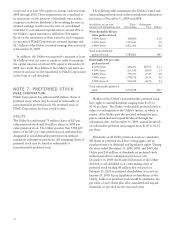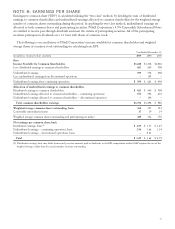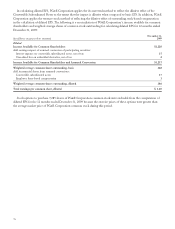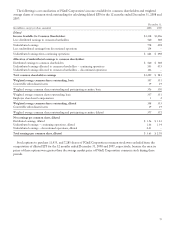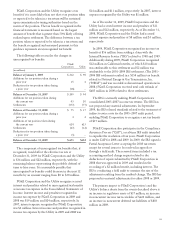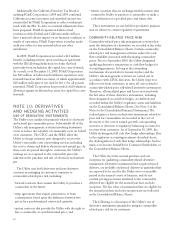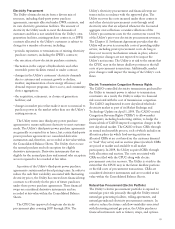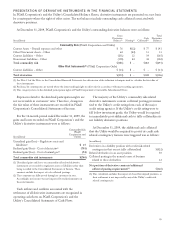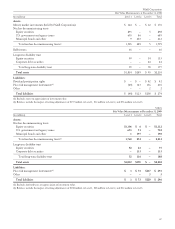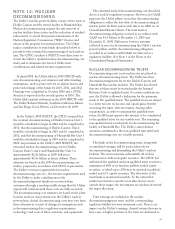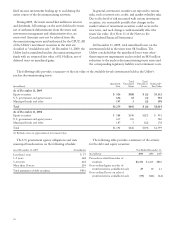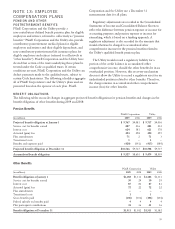PG&E 2009 Annual Report Download - page 88
Download and view the complete annual report
Please find page 88 of the 2009 PG&E annual report below. You can navigate through the pages in the report by either clicking on the pages listed below, or by using the keyword search tool below to find specific information within the annual report.
These financial instruments are considered derivative
instruments and are recorded at fair value within the
Consolidated Balance Sheets.
The Utility manages natural gas price risk associated
with its electric procurement portfolio in accordance with
its risk management strategies included in electricity
procurement plans approved by the CPUC. The CPUC did
not approve the Utility’s proposed electric portfolio gas
hedging plan that was included in the Utility’s long-term
procurement plan. Instead, the CPUC deferred
consideration of the proposal to another proceeding. The
CPUC ordered the Utility to continue operating under the
previously approved gas hedging plan. The expenses
associated with the hedging plan are expected to be
recovered through rates.
Natural Gas Procurement (Small Commercial and
Residential Customers)
The Utility enters into physical natural gas commodity
contracts to fulfill the needs of its small commercial and
residential, or “core,” customers. (The Utility does not
procure natural gas for industrial and large commercial, or
“non-core,” customers.) Changes in temperature cause
natural gas demand to vary daily, monthly, and seasonally.
Consequently, varying volumes of gas may be purchased or
sold in the monthly and, to a lesser extent, daily spot
market to balance such seasonal supply and demand.
The Utility manages its winter exposure to variable
natural gas prices in accordance with its CPUC-approved
annual core portfolio hedging implementation plans.
Accordingly, the Utility has entered into various financial
instruments, such as swaps and options, intended to reduce
the uncertainty associated with fluctuating natural gas
purchase prices. These financial instruments are considered
derivative instruments that are recorded at fair value within
the Consolidated Balance Sheets.
OTHER RISK
At December 31, 2009, PG&E Corporation had $247
million of Convertible Subordinated Notes outstanding
scheduled to mature on June 30, 2010. The holders of the
Convertible Subordinated Notes are entitled to receive
pass-through dividends determined by multiplying the cash
dividend paid by PG&E Corporation per share of common
stock by a number equal to the principal amount of the
Convertible Subordinated Notes divided by the conversion
prices. The dividend participation rights associated with the
Convertible Subordinated Notes are embedded derivative
instruments and, therefore, must be bifurcated from the
Convertible Subordinated Notes and recorded at fair value
in PG&E Corporation’s Consolidated Financial
Statements. Changes in fair value of the dividend
participation rights are recognized in PG&E Corporation’s
Consolidated Statements of Income as non-operating
expense or income (in Other income (expense), net).
VOLUME OF DERIVATIVE ACTIVITY
At December 31, 2009, the volume of PG&E Corporation’s and the Utility’s outstanding derivative contracts was as
follows:
Contract Volume(1)
Underlying Product Instruments Less Than 1
Year
Greater Than
1 Year but
Less Than 3
Years
Greater
Than 3
Years but
Less Than 5
Years Greater Than
5 Years(2)
Natural Gas(3) (MMBtus(4)) Forwards, Futures, and Swaps 288,485,226 167,046,788 15,512,500 –
Options 175,269,728 99,834,308 – –
Electricity (Megawatt-hours) Forwards, Futures, and Swaps 3,830,256 7,787,609 4,652,112 4,233,696
Options 9,400 11,450 136,048 532,444
Congestion Revenue Rights 86,222,176 66,936,541 66,869,998 118,548,809
PG&E Corporation Equity
(Shares) Dividend Participation Rights 16,370,789 – – –
(1) Amounts shown reflect the total gross derivative volumes by commodity type that are expected to settle in each time period.
(2) Derivatives in this category expire between 2015 and 2022.
(3) Amounts shown are for the combined positions of the electric and core gas portfolios.
(4) Million British Thermal Units.
84




